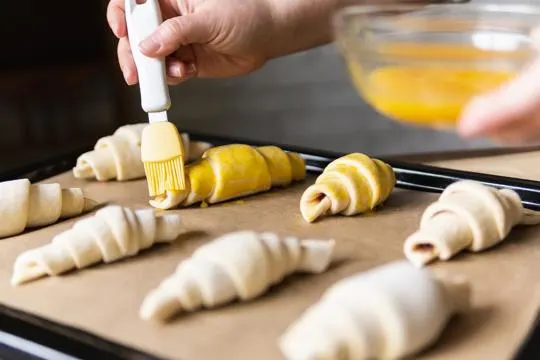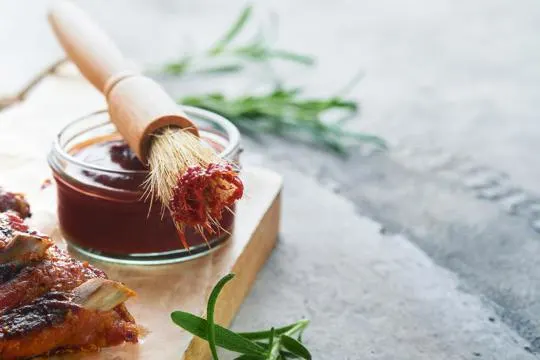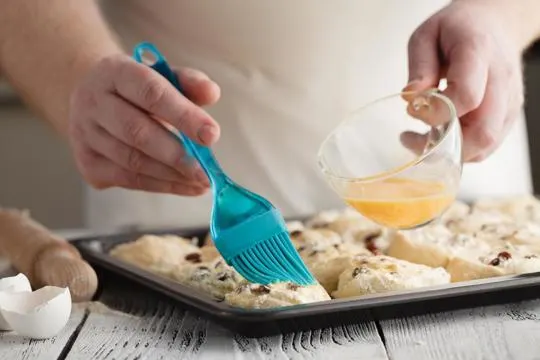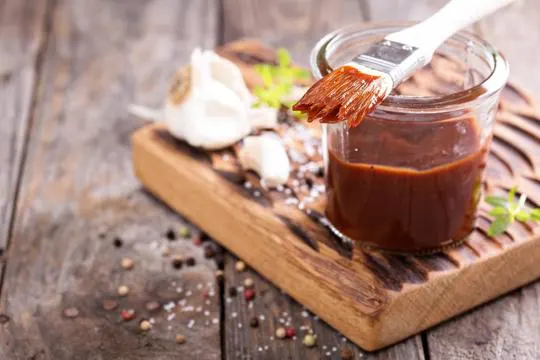Summary of key points
The main difference between a pastry brush and a basting brush lies in the type of bristles and their intended use. Pastry brushes are typically made with soft, natural bristles or silicone bristles and are used for delicate tasks like glazing pastries or brushing egg wash onto baked goods.
Basting brushes, on the other hand, are often made with sturdier, heat-resistant bristles and are used for coating meats and vegetables with marinades or sauces during the cooking process. While both brushes can serve similar functions, their designs make them better suited for different tasks in the kitchen.
Ever stood in the kitchen, pastry brush in one hand and basting brush in the other, wondering what on earth the difference is?
We’ve all been there.
Here’s the lowdown. A pastry brush, typically used for slathering butter or egg wash on baked goods, is like the delicate artist of the kitchen.
Basting brushes, on the other hand, are the heavy lifters, designed for slopping marinades over meat.
The gist?
They’re tools for different jobs. I found this out the hard way during one chaotic Thanksgiving.
We’ll guide you through their unique uses.
No more mix-ups.
What is a Pastry Brush?

A pastry brush, also known as a basting brush, is an essential kitchen tool.
It usually has a handle and bristles made of natural or synthetic materials.
The bristles are designed to evenly spread liquids on food.
The versatility of the pastry brush lies in its precise control when applying liquids.
Soft bristles suit delicate pastries, while firm bristles work well for heavier tasks like barbecuing or basting large cuts of meat.
It’s also useful for greasing pans and brushing egg wash onto dough.
It distributes ingredients evenly for consistent results.
It’s important to clean and store the brush after each use.
Wash it with warm soapy water, rinse and let it air dry.
Store it in a dry place.
In conclusion, a pastry brush is an invaluable tool for any cook or baker.
It’s essential for glazing, basting, and greasing.
A reliable pastry brush will help you create beautiful creations every time.
What is a Basting Brush?

A basting brush is a must-have in the kitchen.
It’s used to apply sauces, marinades or melted butter onto food.
Its bristles are often made of natural or synthetic materials, such as silicone or natural fibers.
The brush’s long handle gives you control and precision when applying.
Grilling? A basting brush is your go-to.
It’s great for adding flavor and moisture to meats and veggies.
Barbecue sauce on ribs? Olive oil on kebabs? This brush makes sure it’s evenly spread.
Plus, you get that lovely glaze on roasted meats like turkey and ham.
Baking? Basting brushes are your friends.
They help you coat pastries with egg washes or spread melted butter over dough.
Now you can get that golden crust on pies, tarts, and loaves.
What sets a basting brush apart is that it can handle high temperatures.
So it’s perfect for use on hot surfaces like grills and ovens.
And many modern basting brushes are dishwasher-safe, so they’re easy to clean after use.
A basting brush adds flavor, plus it looks great.
So when grilling or glazing, don’t forget your trusty basting brush.
Key Differences Between Pastry Brushes and Basting Brushes

Pastry brushes and basting brushes may look alike, but they serve different purposes.
Pastry brushes have softer bristles made from natural materials like boar hair or silicone.
These are gentle and give even coverage without damaging delicate pastries.
Basting brushes have stiffer bristles made from heat-resistant materials like nylon or silicone.
These are perfect for brushing sauces onto hot meats.
Pastry brushes tend to be smaller with a narrower head.
This gives precise application of liquids onto small pastries.
Basting brushes are usually larger with a wider head for coating bigger cuts of meat.
Cleaning is different for these two brushes.
Pastry brushes require extra attention and care as their finer bristles and detail make them harder to clean.
Basting brushes are easier to clean as their larger size and sturdier bristles can withstand more scrubbing.
Choose the right brush depending on the task.
For baking, select a brush that’s gentle and for grilling, choose one that can withstand heat.
Purpose and Usage
The pastry brush and basting brush look alike but have different functions.
A pastry brush is typically used for glazes, egg washes, or butter on pastries, breads, and other baked goods.
Its soft, flexible bristles allow for a delicate application without ruining the dough or crust.
Conversely, a basting brush is mainly used for marinades, sauces, and drippings on meats while cooking.
Its bristles are tougher and can evenly distribute liquids over the meat.
There are times when both brushes can be used.
For example, to brush phyllo dough with melted butter, a pastry brush is best because it won’t tear the dough.
But if you’re making BBQ ribs and want to add a sauce during grilling, a basting brush is ideal.
Its heat-resistant bristles can glaze the meat without damage.
The materials making up these brushes vary.
Pastry brushes may have natural fibers like boar hair or synthetic materials like nylon or silicone.
Basting brushes often come with heat-resistant bristles made from silicone or natural fibers such as cotton or hog hair.
Design and Bristles
Design and Bristles:
Different shapes and sizes of pastry brushes and basting brushes offer unique advantages for specific tasks.
Pastry brushes are narrow in shape, with tightly packed bristles, perfect for precise glazing and egg-washing of pastries or desserts.
Whereas, basting brushes are larger in size with spaced apart bristles, great for distributing marinades or sauces on meats and vegetables.
The bristles of both brushes can be made from natural (animal hair) or synthetic (nylon) materials.
Natural bristles are best for pastries as they hold more liquid and provide better coverage.
Synthetic bristles are best for basting as they can withstand high heat without melting or shedding.
The choice between a pastry brush and a basting brush is up to personal preference and the specific use case.
Having both types of brushes is recommended to fulfill various culinary needs.
Materials Used
Pastry brushes and basting brushes may look the same, but they’re made of different materials.
Pastry brushes are usually natural bristles or silicone.
Basting brushes are made of synthetic fibers or silicone.
These materials affect their performance.
Natural bristles like boar hair are great for pastry brushes.
They’re soft, so they’re good at getting an even finish.
Plus, they don’t melt in hot ovens.
Silicone pastry brushes are heat-resistant and durable.
Basting brushes are for marinades, sauces, and glazes.
Synthetic fiber brushes absorb and retain liquids better.
They’re also more hygienic.
Silicone basting brushes are heat-resistant and easy to clean.
It’s important to know which materials suit your needs.
Whether you’re brushing butter on pastries or slathering sauce on ribs, understanding the difference in materials will make your dishes perfect.
Heat Resistance and Compatibility
Heat-resistance and compatibility are key factors to consider when choosing between a pastry brush and a basting brush.
Both brushes are used to apply sauces, marinades, or glazes, but they have different heat-resistance capabilities and are compatible with different ingredients.
Pastry brushes are made of natural bristles or silicone.
Natural bristles can withstand temperatures up to 500°F (260°C), while silicone brushes can go up to 600°F (315°C).
This makes silicone brushes ideal for grilling and broiling.
Pastry brushes are excellent for applying butter, oil, or egg washes.
Their fine bristles allow for precise application.
They are also well-suited for glazing delicate fruits without causing damage.
Basting brushes, on the other hand, are specifically designed for basting meats while cooking.
They are made of heat-resistant materials such as silicone or nylon.
These brushes have wider heads with thicker bristles that can hold more liquid.
Both brushes are easy to clean.
Pastry brushes can be washed with warm soapy water and air-dried.
Silicone basting brushes can be run through the dishwasher or washed by hand with soap and water.
Similarities Between Pastry Brushes and Basting Brushes

Pastry brushes and basting brushes have many similarities.
Both are designed to evenly spread liquids onto food – like glaze on pastries or marinade on meat.
Both come in various sizes and materials – like natural bristles or silicone.
They need proper cleaning and maintenance – like washing with soap and warm water.
But each type has unique features too.
Pastry brushes have softer bristles, great for delicate egg washes or syrup.
Basting brushes have sturdier bristles, perfect for spreading BBQ sauce or oil on grilled meats.
Applications and Best Uses for Pastry Brushes and Basting Brushes
Pastry brushes and basting brushes have different purposes in the kitchen.
Pastry brushes are used for applying things like egg washes, glazes, and melted butter onto pastries, cookies, or bread before baking.
Basting brushes are mainly used for coating meat with marinades or sauces while cooking.
Pastry brushes are best for delicate tasks.
Their fine bristles and soft texture make them perfect for spreading liquids over pastries without tearing the dough.
These brushes ensure a precise application, resulting in glazed and golden-brown baked goods.
Basting brushes are designed for more robust tasks like grilling or roasting meats.
Their sturdy bristles and heat-resistant properties can handle high temperatures.
Basting brushes make it easy to evenly distribute marinades or sauces over meat, enhancing flavors and keeping the meat moist.
Pastry brushes can also be used for other culinary endeavors.
For example, brushing oil onto pans before sautéing or lightly coating vegetables with sauce before grilling.
Basting brushes may not work as well for delicate tasks like brushing glaze onto pastries due to their stiffer bristles.
Cleaning and Maintenance Tips
Cleaning and maintenance of pastry brushes and basting brushes is essential.
Here are some tips:
- Wash with warm soapy water after each use to get rid of residue or food particles.
- Soak in warm water and vinegar for deeper cleaning.
- Avoid harsh chemicals or abrasives for cleaning as they can damage the bristles.
- Make sure to dry them before storing, as moisture can lead to mold or bacteria.
Remember to:
- Have separate brushes for different ingredients or tasks.
- Follow these tips to prolong the lifespan and ensure hygienic cooking.
Conclusion
After taking a deep dive into the differences between pastry brushes and basting brushes, it is safe to say that they are complementary kitchen tools, not competitors.
While both can be used for various culinary tasks including brushing butter onto toast or oil onto a baking tray, their best use is dependent on the desired cooking result.
Pastry brushes are an ideal tool for delicate tasks such as adding an egg wash to puff pastry while basting brushes are great for coating large pans with sauce or marinade.
With this newfound knowledge, you cannow confidently decide which brush to use without any doubts.
The key element is knowing your specific needs and understanding the features of each device—whether it’s a pastry brush or a basting brush—to support those needs.
Be sure to take proper care of whichever brush you continue using by cleaning it regularly so that your food preparation process always produces superior results.

Leave a comment